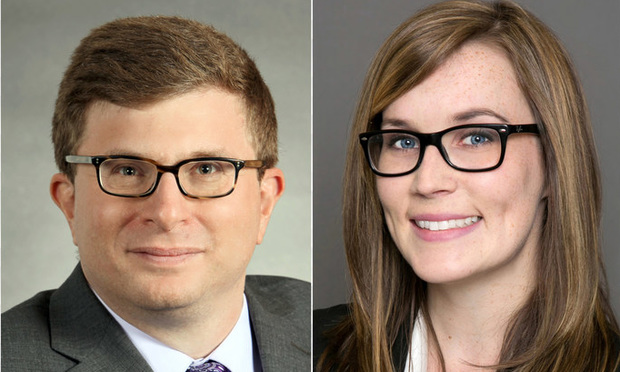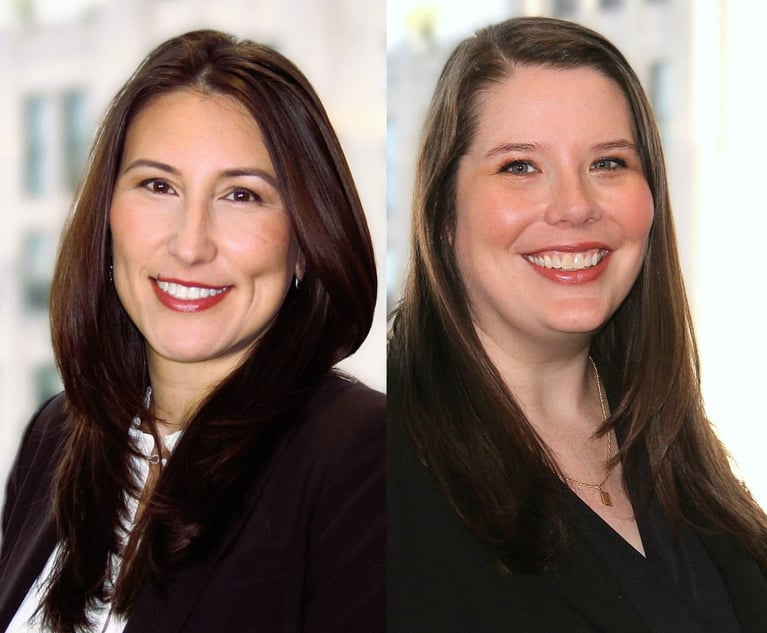'Pollutant' Definition by Georgia Federal Judge Smells Bad, Lawyers Argue
The court's decision clearly ignores Justice Carol Hunstein's wise warning, yielding an absurd result.
August 30, 2018 at 11:52 AM
7 minute read
 Michael Sampson (left) and Caroline Upton of Reed Smith. (Courtesy photo)
Michael Sampson (left) and Caroline Upton of Reed Smith. (Courtesy photo)
In the grand scheme of life, the question whether an odor is a “pollutant” may not be the most pressing philosophical or even scientific question. However, in the more narrow context of insurance-coverage law—which, perhaps not surprisingly, lacks the grand metaphysical questions raised by the study of philosophy—the question is a serious one. While admittedly still not among the most existential questions of our times, the question is nevertheless a vexing one that calls for careful legal analysis.
The most recent U.S. court to address this question was the U.S. District Court for the Middle District of Georgia. That court, however, failed to conduct the exacting analysis necessary to answer the question. Instead, in Recyc Systems Southeast, LLC v. Farmland Mutual Insurance Co., No. 4:17-CV-225 (CDL), 2018 WL 2247247 (M.D. Ga. May 16, 2018), the court, it seems almost reflexively, concluded “that the alleged noxious odors plainly fall within the [relevant insurance] Policy's unambiguous definition of 'pollutants.'” However, that conclusion is far from “plain;” indeed, it is not even correct.
In Recyc, the policyholder operated a “custom fertilizer application business” that “obtains nutrient-rich water disposed of by poultry plants in Alabama and applies the water to local farmland as a type of liquid fertilizer.” As the court explained: “Before [the policyholder] applies the water to the farmland, [it] stores the water in a holding pond that it maintains.”
Allegedly, the water in that pond emitted noxious odors. As a result, upset owners and occupants of property near the pond filed a lawsuit, claiming their property was damaged by those odors, which, they alleged, “travel[ed] onto [their] property, thereby interfering with [their] use and enjoyment of their property.”
In turn, the policyholder tendered the lawsuit to its insurer pursuant to the applicable commercial general liability policy, which provides coverage for, among other risks, “property damage.” The insurance company, however, denied coverage.
Considering whether that denial was appropriate, the federal district court, applying Georgia law, correctly looked to the policy itself. As it explained: “The Policy defines 'property damage' as '[p]hysical injury to tangible property, including all resulting loss of use of that property' and '[l]oss of use of tangible property that is not physically injured.'” Thereafter, the court stated succinctly: “It is undisputed that the alleged injury is 'property damage' under the Policy.” Although the court offered no explanation or further discussion in support of its statement, its conclusion that an odor caused property damage is significant in its own right. For the policyholder, so far, so good.
The court then focused its attention on the policy's pollution exclusion. Here the court's analysis broke down. As is typical, the applicable pollution exclusion, in relevant part, precludes coverage for “'property damage' arising out of the actual, alleged or threatened discharge, dispersal, seepage, migration, release or escape of 'pollutants.'” In turn, the policy defines “pollutants” to mean “[a]ny organic or inorganic substance or material that is a solid, liquid, gaseous or thermal irritant or contaminant, including but not limited to: smoke, vapor, … fumes, … chemicals, … sludge, by-products, … and all other similar chemicals, and waste” (emphasis added). Notably, the policy does not define “irritant,” “contaminant,” or “fumes.”
That said, many courts already have considered exclusions such as this one. And, as many courts have held, such exclusions were intended to apply only to traditional environmental and industrial pollution. The Georgia Supreme Court, however, has taken a contrary stance. In Georgia Farm Bureau Mutual Insurance Co. v. Smith, 784 S.E.2d 422, 425 (Ga. 2016), that court observed: “Expressly rejecting the notion that a pollution exclusion clause is limited to industrial and/or environmental harm, Georgia courts have repeatedly applied these clauses outside the context of traditional environmental pollution.”
Even Smith—which, in the end, held only that lead paint constitutes a “pollutant”—does not stand for the proposition that the application of the pollution exclusion is limitless. Nor does it require the result the federal district court reached in Recyc.
Common sense and the parties' reasonable expectations cannot be ignored. Indeed, the cardinal rule of contract construction in Georgia, as in virtually every other (if not every other) jurisdiction, is to ascertain the intention of the parties.
As Georgia Supreme Court Justice Carol Hunstein stated in her dissent in Reed v. Auto-Owners Insurance Co., 667 S.E.2d 90, 92–93 (Ga. 2008): “[W]here a baldly literal interpretation of the words in an insurance policy would lead to a result no reasonable insured would expect, we have rejected such interpretation. … Indeed, the interpretation advanced by [the insurer] and adopted by the majority stretches the plain meaning of the policy exclusion. When viewed in isolation, the terms “irritant” and “contaminant” are “virtually boundless, for there is no substance or chemical in existence that would not irritate or damage some person or property.” … In short, as construed by the majority, the pollution exclusion functions as a gaping loophole into which the insurer can seek haven in situations in which no reasonable insured would have envisioned the exclusion to apply (internal citations omitted).
The court's decision in Recyc clearly ignores Hunstein's wise warning, yielding an absurd result. As noted above, the court found that “the alleged noxious odors plainly fall within the Policy's unambiguous definition of 'pollutants.'” The court reasoned that the alleged “noxious odors are irritants or contaminants because the Alabama plaintiffs allege that the odors themselves are causing their injury.” However, this reasoning is too simplistic; it would render the exclusion almost limitless. Pursuant to the Recyc court's understanding of the terms “irritant” and/or “contaminant,” smells emanating from a local flower farm or a nearby bakery, for example, likely would constitute an “irritant” and/or “contaminant” if someone simply alleges that they were bothered by the smell or, at the least, that the smell somehow prevented that person from fully enjoying his or her property.
Furthermore—after consulting a dictionary that defined “fumes” as emissions which are “usually odorous and sometimes noxious”—the court also found that “the odors fall neatly within a defined category of pollutants, 'fumes.'” Once again, this reasoning, which appears premised on a baldly literal reading of the policy, seems too simplistic. Once again, it would seem to mean that almost any smell or odor likely would be a “fume” and therefore within the ambit of the pollution exclusion. Once again, the sweet smells of growing flowers or baking cookies would be swept up by the pollution exclusion. Thus, while at its core too simplistic, the court's ruling in Recyc at the same time sweeps too far.
Put simply—and perhaps most appropriately, given the subject matter of Recyc—the federal district court's decision stinks.
Michael Sampson is a Pittsburgh partner in Reed Smith's Insurance Recovery Group. He helps policyholders litigate, otherwise address and resolve complicated insurance coverage matters relating to commercial general liability policies, management liability coverages and other types of insurance, such as property, hull and marine liability and pollution liability insurance.
Caroline Upton is an associate in the Chicago office of Reed Smith and a member of the firm's Insurance Recovery Group. She counsels corporate policyholders and represents them in mediation, arbitration and litigation over a variety of coverage matters, including general liability and business risks, directors' and officers' liability, professional liability cargo and marine claims, first-party property and business interruption risks and product liability.
This content has been archived. It is available through our partners, LexisNexis® and Bloomberg Law.
To view this content, please continue to their sites.
Not a Lexis Subscriber?
Subscribe Now
Not a Bloomberg Law Subscriber?
Subscribe Now
NOT FOR REPRINT
© 2025 ALM Global, LLC, All Rights Reserved. Request academic re-use from www.copyright.com. All other uses, submit a request to [email protected]. For more information visit Asset & Logo Licensing.
You Might Like
View All

CFPB Proposes Rule to Regulate Data Brokers Selling Sensitive Information
5 minute read
Trending Stories
- 1ACC CLO Survey Waves Warning Flags for Boards
- 2States Accuse Trump of Thwarting Court's Funding Restoration Order
- 3Microsoft Becomes Latest Tech Company to Face Claims of Stealing Marketing Commissions From Influencers
- 4Coral Gables Attorney Busted for Stalking Lawyer
- 5Trump's DOJ Delays Releasing Jan. 6 FBI Agents List Under Consent Order
Who Got The Work
J. Brugh Lower of Gibbons has entered an appearance for industrial equipment supplier Devco Corporation in a pending trademark infringement lawsuit. The suit, accusing the defendant of selling knock-off Graco products, was filed Dec. 18 in New Jersey District Court by Rivkin Radler on behalf of Graco Inc. and Graco Minnesota. The case, assigned to U.S. District Judge Zahid N. Quraishi, is 3:24-cv-11294, Graco Inc. et al v. Devco Corporation.
Who Got The Work
Rebecca Maller-Stein and Kent A. Yalowitz of Arnold & Porter Kaye Scholer have entered their appearances for Hanaco Venture Capital and its executives, Lior Prosor and David Frankel, in a pending securities lawsuit. The action, filed on Dec. 24 in New York Southern District Court by Zell, Aron & Co. on behalf of Goldeneye Advisors, accuses the defendants of negligently and fraudulently managing the plaintiff's $1 million investment. The case, assigned to U.S. District Judge Vernon S. Broderick, is 1:24-cv-09918, Goldeneye Advisors, LLC v. Hanaco Venture Capital, Ltd. et al.
Who Got The Work
Attorneys from A&O Shearman has stepped in as defense counsel for Toronto-Dominion Bank and other defendants in a pending securities class action. The suit, filed Dec. 11 in New York Southern District Court by Bleichmar Fonti & Auld, accuses the defendants of concealing the bank's 'pervasive' deficiencies in regards to its compliance with the Bank Secrecy Act and the quality of its anti-money laundering controls. The case, assigned to U.S. District Judge Arun Subramanian, is 1:24-cv-09445, Gonzalez v. The Toronto-Dominion Bank et al.
Who Got The Work
Crown Castle International, a Pennsylvania company providing shared communications infrastructure, has turned to Luke D. Wolf of Gordon Rees Scully Mansukhani to fend off a pending breach-of-contract lawsuit. The court action, filed Nov. 25 in Michigan Eastern District Court by Hooper Hathaway PC on behalf of The Town Residences LLC, accuses Crown Castle of failing to transfer approximately $30,000 in utility payments from T-Mobile in breach of a roof-top lease and assignment agreement. The case, assigned to U.S. District Judge Susan K. Declercq, is 2:24-cv-13131, The Town Residences LLC v. T-Mobile US, Inc. et al.
Who Got The Work
Wilfred P. Coronato and Daniel M. Schwartz of McCarter & English have stepped in as defense counsel to Electrolux Home Products Inc. in a pending product liability lawsuit. The court action, filed Nov. 26 in New York Eastern District Court by Poulos Lopiccolo PC and Nagel Rice LLP on behalf of David Stern, alleges that the defendant's refrigerators’ drawers and shelving repeatedly break and fall apart within months after purchase. The case, assigned to U.S. District Judge Joan M. Azrack, is 2:24-cv-08204, Stern v. Electrolux Home Products, Inc.
Featured Firms
Law Offices of Gary Martin Hays & Associates, P.C.
(470) 294-1674
Law Offices of Mark E. Salomone
(857) 444-6468
Smith & Hassler
(713) 739-1250







